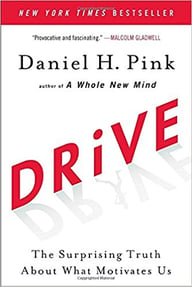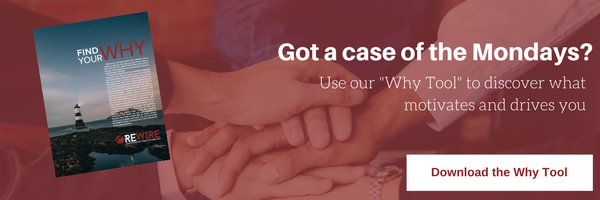
Motivation is a massive industry. People across the globe (and most certainly in our culture) pay a lot of money
,
and spend a great deal of time looking for ways to further motivate themselves. One of my favorite shows about work is the American version of The Office. And one of my favorite scenes is of the salesman, Dwight, getting himself motivated for a sales call by locking himself in the backseat of a car, head-banging to thrash metal music, and punching the headrest in front of him.
That might not work for most of us, but we all have our sources of motivation. It could be some other type of music or a video. Some people get motivation from books they read
,
or seminars they attend. Some people look for motivation in larger paychecks. Some people, unfortunately, only seem to get motivated when they're threatened with losing something: a client or a job or a relationship. And that external threat of loss drives them to perform better.
But what I notice about most common sources of motivation is that they share two features: They are primarily
external to us (money, job, books, music, etc.) and they are
temporary. That is, the motivational effect that these external sources provide doesn't last. We don't stay motivated from them.
Actually, we have known this for a long time. But the rush of feelings we get when we are externally motivated leads us to continue buying the books, attending the seminars
,
and making resolutions - in spite of the fact that it doesn’t work long-term.
Daniel Pink and the search for authentic motivation for work
In his masterful book Drive, author Daniel Pink states that as a culture, we continue to believe that "carrots and sticks" are the sources of motivation. We either
gravitate toward the carrot (the promise of an external reward for our actions) or the stick (the threat of negative consequences if we don’t act). Through his extensive research, Pink proves that these techniques
do not
serve us well. Yet we see countless examples of carrots and sticks everywhere we look.
Thankfully,
his
book is not just about things that don’t work, and he goes into great detail about what the science says
does work. If we want to be motivated, then we need to move toward the type of motivation that can be sustained
internally in the face of many obstacles.
Pink argues that there are
three specific concepts that will serve us well if we are willing to set aside what we have always done. The three concepts are
Belief,
Freedom, and
Story - and
Pink refers to them as
Mastery,
Autonomy, and
Purpose.
An understanding of these concepts is key if you are looking for an authentic, long-term solution for your personal motivation issues. I've also found these concepts to be very powerful if you're a leader and groups at work look to you to help motivate the business as a whole.
We will write more in
future article
about these concepts, but, in short:
-
Belief is about understanding whether or not we even have the belief that change or improvement is possible.
-
Freedom is
about
the idea that we are not motivated by compulsion, but rather on the freedom to choose.
-
Story
is all about knowing the big WHY behind what we do.
So if you want to embark upon a new strategy, roll out a new way of doing business, or finally start an exercise plan, then you need to call into question your beliefs, your sense of obligation versus freedom, and fully unearth your WHY behind it. These are all very rich concepts, and each will lead us to
sustainable change because we have moved from external motivation to motivation from the inside out.
Let's work on rewiring the way we focus on motivation - we may even learn something new about ourselves in the process!




